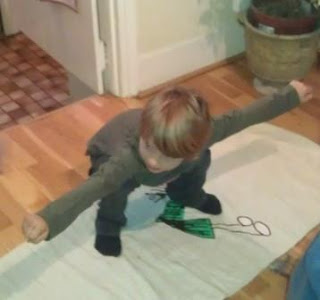It's Halloween! Tatty Bumpkin's Owl Yoga activity is a fun and spooky way for your child to stretch out their back and chest muscles – so good for a healthy posture... and writing skills.
Owl Pose – Tatty Bumpkin’s Yoga Activity for the Week
- Try to do Owl pose with your child - they will find it much easier to do if they can copy you and doing the pose together will support the bonding process between you both. Do respect your body though - if you know you have any health issues i.e. back, neck problems always consult a health professional first.
- Find a clear place on a non-slip surface e.g. mat or carpet where you can both do Owl pose without bumping into anything.
- Remember to take off socks and shoes – this will enable you and your child to use your feet effectively as you move in Owl pose.
- Start Owl pose either:
- Curling up on your mats, with your arms tucked in (see picture above) or
- Sitting back on your heels opposite each other - with your arms resting by your sides
- Then ‘Twit, twoo!' kneel up together - flap your big owl wings by spreading your arms out wide to either side and then taking your arms right up above your heads so your left and right hands touch. See picture above. Hoot “Twit-twooo!”
- Repeat Owl pose several times encouraging your child to really streeeetch their arms out wide – they may be surprised how far their arms can reach. These arm movements are the perfect antidote to computer games, 'texting' and typing. They prompt your child to gently stretch out their shoulder, back, chest and neck muscles in a fun way that feels comfortable to them.
Adaptations and Progressions
To make Owl Pose Easier
If you notice your child is finding it hard to take their arms out to their sides and above their head whilst balancing in kneeling – guide them to do the arm movements of Owl pose sitting cross-legged on the mat or carpet. It's far better that your child does wide, accurate arm movements so they can experience the stretch in their upper body.To make Owl Pose Harder
- Start in the squatting position on your mat, balancing on your toes, with your arms by your sides – encourage your child to copy you.
- Together come up into standing waving your arms over your head as before. Hoot “Twit Twooo!” Bring your arms back down to your sides as you squat down.
- Repeat a few times with your child to be truly wise owls!
Benefits of Tatty Bumpkin’s Owl Yoga Activity for Your Child
Owl pose will give your child the opportunity to:1. Strengthen their core muscles
As your child does Owl pose they will be activating and strengthening their ‘core’ muscles - especially their back and shoulder muscles. Strength in these muscles is not only important for more complex sporting skills e.g. rugby, dance or tennis, but also is crucial for good posture, writing skills and daily living skills e.g. dressing.
2. Mobilise and gently stretch their chest muscles
As your child spreads their arms out to either side in Owl pose they will be stretching their ‘pectoral’ muscles which run across the front of their upper chest. These muscle groups can often become tight because - as children do activities such as writing, typing, using mobile phones they are holding these muscles in the shortened position.
3. Develop their balance skills
As your child does Owl pose they will be refining their balance skills. Balance is a complex process - as children learn to sit, stand and move around they will be developing mature ‘balance reactions’ naturally. If you provide your child with plenty of (safe) opportunities to gently challenge their sense of balance this will help them to refine their balance reactions further.
4. Strengthen their hip and leg muscles
If you child is doing the harder version of Owl pose, moving from squat to stand, they will be specifically strengthening their hip and leg muscles.
Love Tatty Bumpkin x
Find out about your local Tatty Bumpkin class at http://www.tattybumpkin.com/classes/find-class.html. Or, ask your child’s nursery if they are doing Tatty Bumpkin Yoga activity sessions as part of their day.
A New Start with Tatty Bumpkin?
Or, maybe, you are thinking of a new career which gives you:- The opportunity to work with kids
- A great sense of job satisfaction and
- Flexible working to fit around your own family


















